Text and Photos By Jeffrey A. Rendall
|
|
HILTON HEAD ISLAND, SC -- It's hard to imagine these days, but Hilton Head Island was once a sparsely populated and little known coastal island -- inhabited mainly by descendents of freed slaves and a variety of wild creatures.
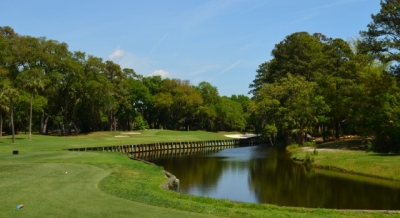 |
| The par three 3rd hole bears striking resemblance to the famous Harbour Town Golf Links. |
In contrast, today it's a thoroughly developed paradise of recreation and vacation -- still populated by some generations-old families, but also by a healthy retired population and a massive influx of tourists.
What accounts for the difference is a very long story, but it's safe to say that golf course development was a big reason why the island's become what it is. Someone thought this otherwise non-descript island would be a good place to carve out some holes, put up a few flag sticks and attract visitors and permanent residents -- and the idea stuck.
The golf boom that's led to the 'current' Hilton Head Island was started by the Ocean Course at Sea Pines. Opening in 1960 (designed by George Cobb), the Ocean course was the centerpiece of Sea Pines Plantation, the first planned community of its kind (developed by the Fraser family). So I guess you could say that not only did the Ocean Course start a golf eruption in the Hilton Head area, but Sea Pines also began the planned community explosion that's swept across the entire country.
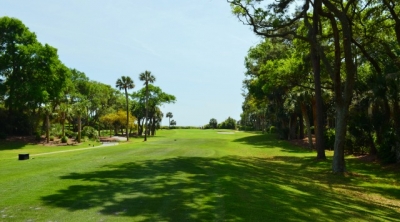 |
| Sea Pines' Ocean Course's 15th hole is one of two on Hilton Head Island that fronts the ocean. |
Bobby Downs, Head Golf Professional at Sea Pines' Ocean course, says Hilton Head Island's 'untamed' nature helped promote it in the early days: "I found some articles about the early days of development here on the island, and they really highlight the wildlife -- apparently there were monkeys roaming the island at that time, as well as boar, deer, and of course, lots of alligators."
Downs continues, "Sea Pines' golf courses were developed for all different levels of golfer. The routing was done through the natural vegetation -- specifically highlighting many different oak trees and the natural lagoon systems that were in place."
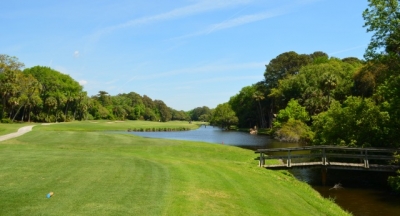 |
| Coming to Hilton Head Island, expect lots of water and wetland carries off the tee from the back sets of markers. Here, the 2nd hole. |
But the Ocean course gets its name from its most famous hole, the 15th -- a par three that meets the ocean. Downs said there was quite a hullabaloo raised over the hole when it was built, because the Fraziers spent $120,000 just to build that hole. In retrospect, it was probably worth it -- it's one of just two true 'ocean' holes on Hilton Head Island, the other being the 10th at the Robert Trent Jones course at Palmetto Dunes.
The course itself is certainly an old-style classic with a modern look to it, thanks to a significant upgrade in 1995 by Mark McCumber's design group. Downs comments on the face-lift: "By the mid-nineties, we felt the Ocean course really needed an upgrade. Players these days like challenge in their golf course designs, so we brought in McCumber to add some modern touches while preserving the original design's character. It's very difficult to take out trees on the island (because of restrictions), so he essentially enhanced the existing natural features in the layout. "
"As far as the alterations, he literally changed the entire golf course, but in subtle ways -- all the greens and tees were moved to some extent. We lengthened the course by about 300 yards. More forced carries were added to 'toughen it up,' but McCumber was careful to always leave a bailout area when a lengthy forced carry is called for. So it's still very forgiving like the original George Cobb design was, but a little more in line with what the better golfers want from a golf course these days," Downs adds.
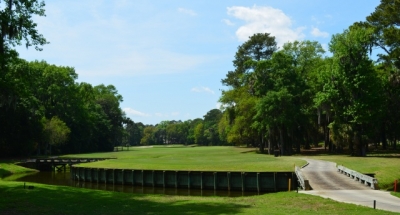 |
| You'll have to try and work the ball right to left to leave a good angle for your second shot on the par four 13th hole. |
Having never played the course prior to its remake, I can't say how the changes impacted the layout. All I can say is the 'current' Ocean course presents a very enjoyable, player-friendly golf experience, with a surprising amount of variety for a golf course winding in and out of established residential neighborhoods.
Its wide fairways shed little allusion to its more famous neighbor -- Harbour Town Golf Links, site of the RBC Heritage every April -- but I'd guess the average resort player will have a better time on the Ocean Course, especially if score is the determining criteria. Playing Harbour Town's a thrill, don't get me wrong. Just standing on the eighteenth tee with the lighthouse in the distance is enough for me -- but it's a tough, tough golf course.
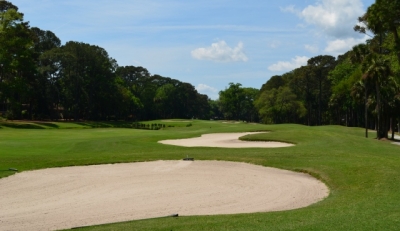 |
| Turning the corner on the par five 4th hole, which is reachable in two if you avoid the trouble near the green. |
The Ocean Course, by comparison, is a lot tamer. You will have to drive straight to score well because there's a great deal of water on the course -- it comes into play on twelve holes (not including the ocean hole). McCumber emphasizes strategy to a large extent, so some holes play very target oriented. There are some Harbour Town visuals out there too -- in the form of railroad-tie-lined lagoons. It's very picturesque.
Downs says he sees a lot of McCumber's game in the layout: "McCumber in his playing days liked to fade the golf ball. He realized that 75% of the players out there also tend to fade (I'd say it's more like 'slice'), so he's made the course very friendly to someone who has those tendencies -- a low ball hitter that moves the ball from left to right. Contrast that to Jack Nicklaus, who wants players to bring shots in high and land soft, which tends to favor better golfers. The average player will probably have more success on a course like the Ocean course."
The greens are large and undulating in resort fashion, mandating good placement from your iron play, though I certainly wouldn't describe the pace as overly challenging. You can give the ball a pretty good rap to reach the hole -- boldness is not punished here.
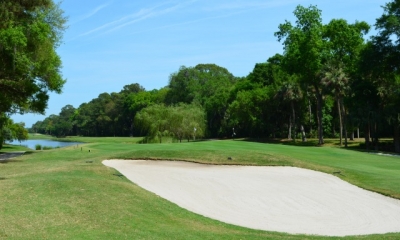 |
| From this spot near the 16th green, it's easy to see why golf is so popular at Sea Pines.. |
One other aspect of the 1995 renovation -- was a complete reworking of the Ocean Course's (which it shares with its sister course, Heron Point by Pete Dye) practice facilities. Downs said Sea Pines wanted to emphasize its teaching/learning programs, so they built three different putting greens, an additional chipping area, two teaching tees, and a learning academy that hosts an international junior program. The international junior program is a ten-month program where 52 kids from around the world attend 'regular' school and then practice their golf everyday. It's a far cry from my school days!
Downs said one of the things he likes best about the Ocean course is it starts out difficult, eases up some, then finishes tough. That's true -- you'll certainly remember the opening and closing sequences -- hopefully for triumph instead of failure.
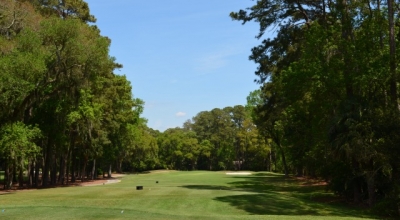 |
| The view from the tee of the part three 7th. |
You better take advantage of Sea Pines' fine practice facilities before your round, because your first shot of the day will test your driving skills. Not exactly a huge forced carry, but there's water on both sides of the landing area should you hook or slice a tad too much, and not even a fairway bunker to save you if you're headed in those directions. The green is protected by bunkers left and right, however, so split the difference.
The second hole's got water to the right and out of bounds left, and this time the approach shot's got to carry a lagoon to another well bunkered green. At about this time you're thinking McCumber wasn't in a good mood when he redid the course -- and if you've gotten through the first two holes near par, you'll probably set up well for a good score the rest of the front nine.
Four is a 527 yard dogleg left par five that's a legitimate three-shot hole for most everyone -- because you'd have to carry more water and two strategically placed bunkers with a fairway wood to reach the green in two. If you manage it right, this hole will set up well for a birdie chance, however.
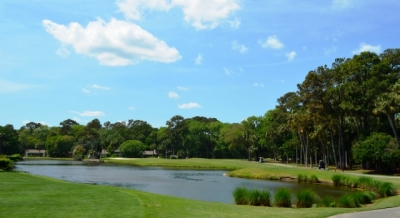 |
| One of the toughest carries on the Ocean Course is here at #10. Hook it just a bit and you're swimming with the gators. |
Skipping to nine, you'll find the second par five will also challenge your target hitting skills. The difficulty starts on your second shot, where you'll need to measure a distance to lay-up, then pick the proper club to execute the shot, avoiding bunkers and water to the extreme left. Again, if you're in good position, this large green should surrender a potential birdie putt after a short third shot.
The view from the tenth hole will probably scare you after several non-carry tee shots from the previous quintet of holes -- because there's a sizeable carry over water. The second shot, again, must avoid greenside bunkers well placed left and right.
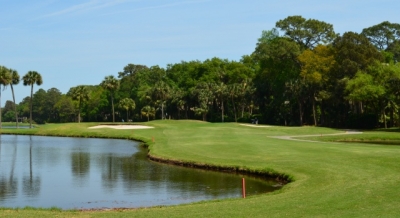 |
| The par four 17th hole begins a long and challenging two hole finishing stretch. |
Thirteen's yet another double-target with water threatening the entire right side of this 410 yard hole, and then wrapping around in front of the putting surface. This hole earns its #4 handicap designation, visually intimidating and tough to avoid the 'double trouble.'
The signature hole fifteenth lies next to the ocean. McCumber heightened the tee box, giving players a better view of the beach beyond. The hole itself is a fairly easy 210 yard par three (very little trouble), but you'll probably remember this hole for its aesthetic qualities -- not whether you made a par or bogey.
Seventeen and eighteen present quite a difficult closing stretch. Downs says: "Some of the biggest changes McCumber made involve seventeen and eighteen. Seventeen used to be a shortish par five, and eighteen a long par four -- so McCumber 'flipped' them and added some length. So now seventeen's a long par four, and eighteen's a long par five."
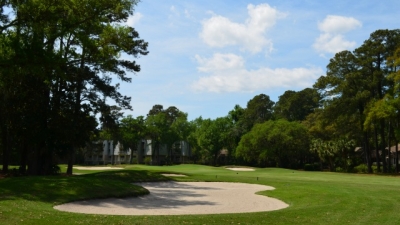 |
| Every shot is nicely framed on the Ocean Course. Here, the par four 8th hole. |
Seventeen's the number two handicap hole, but plays second fiddle in difficulty to no link. Even the yardage book says it's 'one of the most difficult par 4's you will ever play.' 455 yards with a double target (sounding redundant here), this is one hole where fading will get you in trouble, as there's water down the entire right side -- and there's out of bounds to the left. The second shot's more difficult than the drive, if that's possible, as the green's protected by a lagoon and four bunkers. A small landing area short could save you if you miss there.
Downs says seventeen and eighteen also play into the wind ten months a year, which makes them even more difficult. Eighteen's no picnic either, 560 yards with water all down the right side again, but a ton of room to the left (there is OB left, but you'd have to be pretty far gone). Measure your lay-up shot carefully, as the water encroaches on the fairway in a couple spots, and there are several large bunkers to the left if you try too hard to avoid the water on the right. Luckily, the green's huge on this hole!
Sea Pines' Ocean course is very representative of golf on Hilton Head Island -- lots of natural beauty, some challenge, a few alligators and yes, even homes lining the holes. It's not hard to see how this course started the area's development boom, because it's on a fine piece of land, as is all of Sea Pines -- rich fodder for many memorable moments.
Details:
The Ocean Course At Sea Pines Resort
100 North Sea Pines Drive
Hilton Head Island, SC 29928
Phone: 843-842-8484 and 1-800-SEAPINES
FAX: (843) 363-4501
Website: http://www.seapines.com/golf/ocean-course.asp
Head Golf Professional: Bobby Downs
Course Architects: George Cobb & Mark McCumber.
|
|
Yardage/Slope |
Rating |
|
McCumber |
6906/133 |
72.8 |
|
Championship |
6493/130 |
71.4 |
|
White |
6172/125 |
69.7 |
|
Green |
5325/124/115 |
71.1 |
Rates: (Seven Days a Week)
Check the Sea Pines website for current rates and reservations.
| Related Links | Comments on this article? | |
|
Maryland National Golf Club Hollow Creek Golf Club Rocky Gap Resort PB Dye Golf Club in Ijamsville Whiskey Creek Golf Club |
E-mail Jeff Rendall, Editor: jrendall@golftheunitedstates.com |












